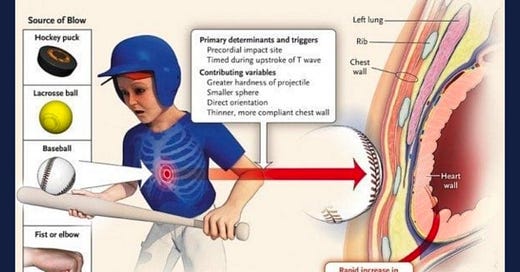Last night and into today, numerous doctors on Twitter have said they’re sure the Covid-19 vaccine had nothing to do with Damar Hamlin’s sudden collapse on the field during the Buffalo Bills game, with several saying it was most likely caused by ‘commotio cordis.’
Here’s one of them:


First, there’s no reason not to consider all possibilities, and we should be suspicious of anyone trying to silence others who are asking whether it could possibly be the Covid-19 vaccine.
Of course it could be as the only side effect for the mRNA vaccines that the CDC has really acknowledged is myocarditis — inflammation of the heart muscle — which most often afflicts adolescents and young adult males.
Myocarditis, the Oxford study published in August showed, can indeed be deadly: Vaccine-associated myocarditis resulted in the death of 100 people in Great Britain in just one year, it showed.
And Second, the rush to identify ‘commotio cordis’ — a condition few Americans have heard of — is a stretch.
Commotio cordis is caused by a sudden strike to the chest, in the area of the heart, at the exact moment when the heart is re-setting itself.
But a search of the New York Times, known for decades for the breadth and depth of its sports reporting, shows no instance in which any football player, at the high school, college level of in the NFL, was ever identified as collapsing or dying due to commotio cordis.
The only Times articles that mention cases of commotio cordis in the context of sports involve a 12-year-old boy, a pitcher on a New Jersey baseball team, getting hit in the chest by a line drive (his heart stopped, but he was revived with a defibrillator that someone had at the field); and a 16-year-old hockey player from Massachusetts who was hit in the chest with a puck and died. There is also a vague mention of lacrosse players.
The stories all involve a small object traveling at a high rate of speed and hitting the victim in a particular place on the chest.
“In commotio cordis victims, the chest blows strike the left chest,” a 1995 study found. “Most of these blows reportedly occur directly over the cardiac silhouette; however, the exact location of the chest wall strike cannot always be determined with precision.”
A 2002 study found that 58 percent of commotio cordis events were in baseball/softball players and 16 percent in hockey players and that the great majority involved a projectile.
Of a total of 128 cases — which includes all reported cases plus cases found by researchers reviewing newspaper databases over more than four decades — only five were in people playing football.
So, in American history, using a method that includes scouring all newspaper reports in the United States over decades (until 2001) there were only five cases of commotio cordis for people playing football at the elementary, middle, high school, college and professional level.
Also, only 22 percent of all of the 128 cases of commotio cordis were in people age 18 and older — meaning that three-quarters of cases were in minors.
This puts the risk of an adult football player experiencing commotio cordis at close to zero.
There is almost zero chance, statistically, that Damar Hamlin’s heart stopped beating because of commotio cordis.
A more recent article, written in 2010 by the same author, cardiologist Barry J. Maron, listed a total of 224 cases of commotio cordis in the registry Maron maintains in Minneapolis. This includes all cases ever found to have occurred, or likely to have occurred, in recent decades in the United States.
But another thing to consider is the tackle itself.
A close review of the tackle Hamlin made right before he stood up and then fell back on the field seems to show no targeted, direct hit to his chest.
One sports analyst said he thought the ball-carrier, Cincinnati Bengals wide receiver Tee Higgins, put his head down at the last moment and that because he did this, his helmet hit Hamlin’s chest directly.

But the photos and video of the tackle do not show anything like this. Tee Higgins is already on his back with Damar Hamlin on top of him by the time Higgins’ helmet is near Hamlin’s chest area.

Emergency responders used a defibrillator to shock Hamlin’s heart back into beating before Hamlin was taken by ambulance to the University of Cincinnati Medical Center, where he remains in critical condition as of this afternoon.
The importance of being able to discuss the possible cause of Hamlin’s sudden and shocking cardiac event should be evident: If we know or have reason to believe the Covid-19 vaccine caused Hamlin’s heart to stop, more lives can be saved by stopping vaccine mandates and advising athletes and others who have been vaccinated to take precautionary measures to avoid heart attacks and strokes.
******
Chart below from the 2010 article by Dr. Maron published in the New England Journal of Medicine:
Keep reading with a 7-day free trial
Subscribe to Crossroads Report to keep reading this post and get 7 days of free access to the full post archives.




